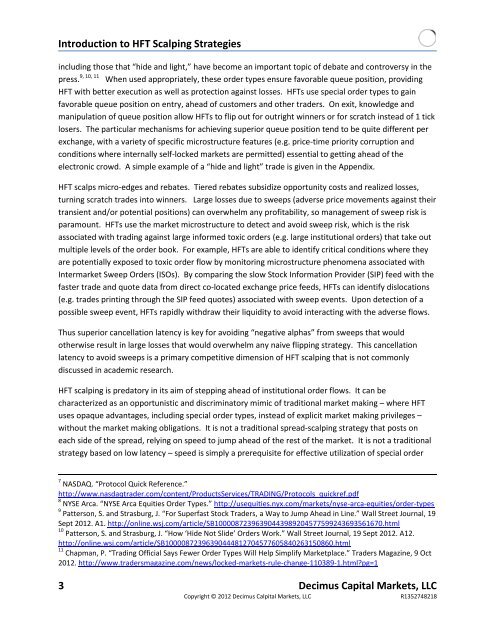IntroHFTScalpingStrategies
IntroHFTScalpingStrategies
IntroHFTScalpingStrategies
You also want an ePaper? Increase the reach of your titles
YUMPU automatically turns print PDFs into web optimized ePapers that Google loves.
Introduction to HFT Scalping Strategies<br />
including those that “hide and light,” have become an important topic of debate and controversy in the<br />
press. 9, 10, 11 When used appropriately, these order types ensure favorable queue position, providing<br />
HFT with better execution as well as protection against losses. HFTs use special order types to gain<br />
favorable queue position on entry, ahead of customers and other traders. On exit, knowledge and<br />
manipulation of queue position allow HFTs to flip out for outright winners or for scratch instead of 1 tick<br />
losers. The particular mechanisms for achieving superior queue position tend to be quite different per<br />
exchange, with a variety of specific microstructure features (e.g. price-time priority corruption and<br />
conditions where internally self-locked markets are permitted) essential to getting ahead of the<br />
electronic crowd. A simple example of a “hide and light” trade is given in the Appendix.<br />
HFT scalps micro-edges and rebates. Tiered rebates subsidize opportunity costs and realized losses,<br />
turning scratch trades into winners. Large losses due to sweeps (adverse price movements against their<br />
transient and/or potential positions) can overwhelm any profitability, so management of sweep risk is<br />
paramount. HFTs use the market microstructure to detect and avoid sweep risk, which is the risk<br />
associated with trading against large informed toxic orders (e.g. large institutional orders) that take out<br />
multiple levels of the order book. For example, HFTs are able to identify critical conditions where they<br />
are potentially exposed to toxic order flow by monitoring microstructure phenomena associated with<br />
Intermarket Sweep Orders (ISOs). By comparing the slow Stock Information Provider (SIP) feed with the<br />
faster trade and quote data from direct co-located exchange price feeds, HFTs can identify dislocations<br />
(e.g. trades printing through the SIP feed quotes) associated with sweep events. Upon detection of a<br />
possible sweep event, HFTs rapidly withdraw their liquidity to avoid interacting with the adverse flows.<br />
Thus superior cancellation latency is key for avoiding “negative alphas” from sweeps that would<br />
otherwise result in large losses that would overwhelm any naive flipping strategy. This cancellation<br />
latency to avoid sweeps is a primary competitive dimension of HFT scalping that is not commonly<br />
discussed in academic research.<br />
HFT scalping is predatory in its aim of stepping ahead of institutional order flows. It can be<br />
characterized as an opportunistic and discriminatory mimic of traditional market making – where HFT<br />
uses opaque advantages, including special order types, instead of explicit market making privileges –<br />
without the market making obligations. It is not a traditional spread-scalping strategy that posts on<br />
each side of the spread, relying on speed to jump ahead of the rest of the market. It is not a traditional<br />
strategy based on low latency – speed is simply a prerequisite for effective utilization of special order<br />
7 NASDAQ. “Protocol Quick Reference.”<br />
http://www.nasdaqtrader.com/content/ProductsServices/TRADING/Protocols_quickref.pdf<br />
8 NYSE Arca. “NYSE Arca Equities Order Types.” http://usequities.nyx.com/markets/nyse-arca-equities/order-types<br />
9 Patterson, S. and Strasburg, J. “For Superfast Stock Traders, a Way to Jump Ahead in Line.” Wall Street Journal, 19<br />
Sept 2012. A1. http://online.wsj.com/article/SB10000872396390443989204577599243693561670.html<br />
10 Patterson, S. and Strasburg, J. “How ‘Hide Not Slide’ Orders Work.” Wall Street Journal, 19 Sept 2012. A12.<br />
http://online.wsj.com/article/SB10000872396390444812704577605840263150860.html<br />
11 Chapman, P. “Trading Official Says Fewer Order Types Will Help Simplify Marketplace.” Traders Magazine, 9 Oct<br />
2012. http://www.tradersmagazine.com/news/locked-markets-rule-change-110389-1.html?pg=1<br />
3 Decimus Capital Markets, LLC<br />
Copyright © 2012 Decimus Calpital Markets, LLC R1352748218


